
All categories
Featured selections
Trade Assurance
Buyer Central
Help Center
Get the app
Become a supplier

(2905 products available)



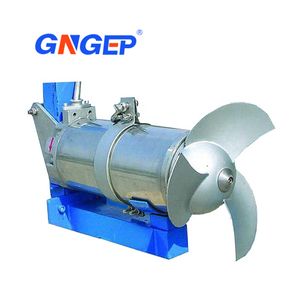





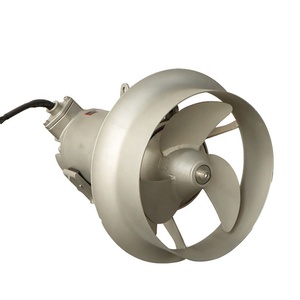
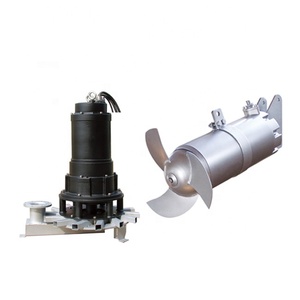

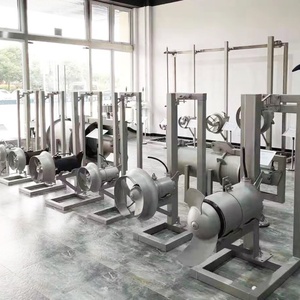


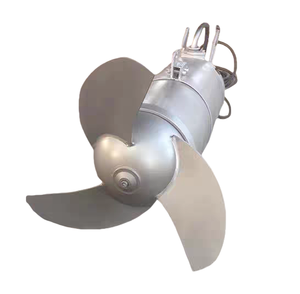





A submersible mixer is a pump that operates inside a liquid medium. It uses the impeller to stir sludge, giving it a homogeneous appearance. Several types of submersible mixers are distinct based on the pump design and mixing method.
Axial Mixers
Axial submersible mixers have blades or impellers fixed to the motor shaft. They push the liquid in the axial direction or parallel to the shaft. These mixers have a simple design and work on low shear force. Therefore, they are ideal for mixing shallow depths of liquids with low viscosity. Businesses use them for mixing water, nutrients, and chemicals in ponds, reservoirs, and wastewater treatment plants.
Radial Mixers
Radial submersible mixers have impellers that push or pull liquid to the side in a perpendicular direction. They provide high mixing intensity at low speeds. The radial mixer is ideal for handling liquids with high volumes and depths. They are used in hydrodynamic processes like emulsification, dispersion, and polymerization. Many radial mixers come with multiple impeller arrangements to cater to different mixing requirements.
Helical Mixers
The helical mixer has an impeller that mimics a screw thread. It provides axial and radial flow, giving customers better performance. These mixers are suitable for deep tanks with sediments at the bottom. They eliminate the sediments to ensure a uniform mixture of liquid. Also, the helical mixer operates at low speeds, reducing the noise level.
Axial Radial Mixers
This mixer combines the benefits of the axial and radial mixer. It has an axial flow pump with a radial impeller. The mixer reduces power consumption while improving flow and mixing. Also, it uses a small quantity of polymer to create a large bubble inside the tank to reduce the cost of chemical use.
The specification of a Submersible Mixer may vary depending on application needs; however, the following are some common specifications:
It is very important to maintain a submersible mixer so that it can work well even after a long period of usage. Here are some maintenance tips that mixer users can consider:
In summary, submersible mixers have significant usage scenarios in various environmental and industrial sectors. Their ability to uniformly mix and distribute liquids, chemicals, and treatment agents makes them indispensable in wastewater treatment, storage, marine environments, and environmental remediation.
When selecting suitable submersible mixers for business applications, there are several critical factors to consider.
Flow characteristic requirements
It is essential to determine the type of flow needed to be formed by the mixer, like turbulence or shear strength, and the quantity of flow that needs to be generated.
Tank dimensions and depth
The size and depth of the tank or chamber in which the mixer will be used should also be determined, as this will affect the dimensions and power of the mixer.
The media to be mixed
The type of material to be mixed, its viscosity, density, temperature, and any other specific characteristics, should also be considered.
Operating environment
The conditions in which the mixer will be operated, including temperature, pressure, and any hazardous or corrosive environments, should be taken into account to ensure that the mixer is suitable for the environment.
Energy requirements
Determine the power requirement of the mixer based on the viscosity and the desired mixing quality, which includes considering the energy efficiency of the mixer.
Equipment integration needs
When selecting a mixer, it is also essential to consider how it will integrate with other equipment in the system, like pumps, sensors, and control systems.
Financial factors
Finally, the initial investment and operating costs of the mixer, including maintenance and repair costs, should also be considered.
Q1: Will a submersible mixer work in any shape or size of tank?
A1: Submersible mixers are very versatile in terms of being able to work in tanks of different shapes and sizes. However, while they can be expected to work in most tanks of different shapes and sizes, they can only do so if the tank is of a reasonable size.
Q2: Can the flow created by submersible mixers be manipulated?
A2: Yes, one of the many advantages of submersible mixers is that the flow they create can easily be manipulated. Typically, the positioning and angle of the mixer can be adjusted to give rise to the desired flow pattern.
Q3: Are submersible mixers safe to use in explosion-proof environments?
A3: Yes, submersible mixers are generally safe for use in explosion-proof environments. They come with explosion-proof motors that comply with the relevant standards. However, to ascertain utmost safety, buyers should consult the suppliers to ensure that the right mixer is selected for their specific application.
Q4: How can someone ensure that their submersible mixer is energy efficient?
A4: To ensure that a submersible mixer is energy efficient, buyers should look for a mixer with an energy-efficient motor. Also, they should ensure that the mixer is properly sized for their application. Finally, they should consider investing in variable frequency drives (VFDS).